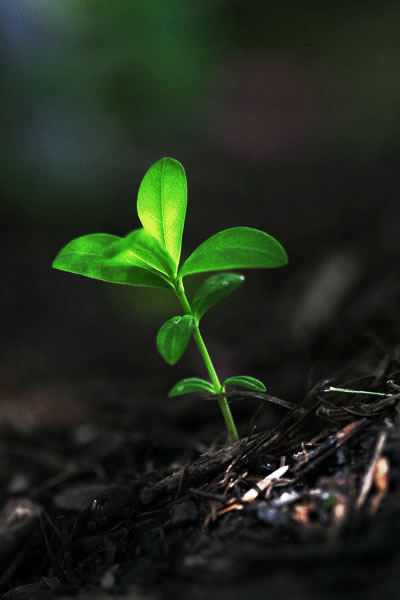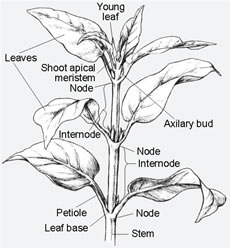 |
| Shoots |
“Shoot” is a term used to refer collectively to the stem and associated leaves of a vascular plant.
The stem of a vascular plant is typically a cylindrical, above ground axis that grows upright, away from the pull of gravity. Young stems are green and photosynthetic, and in some plants, such as horse tails and most cacti, the stems are the primary site of photosynthesis.
In most plants, however, the primary function of the stem is to support leaves in a position where they are well exposed to light. The part of the stem where a leaf attaches is a node. The section of stem between nodes is an internode. Internode elongation spaces the leaves and is responsible for most of the increase in length of the stem every growing season.
  |
The cylindrical shape of the stem is a structural adaptation that provides maximum strength per volume of tissue. The vascular tissues, which contain tough, thick-walled fiber cells, contribute to the strength of the stem. In non-seed plants, such as ferns, these tough cells form a core in the center of the stem with softer tissues around them.
In seed plants, such as conifers and flowering plants, the vascular tissues tend to lie in a subperipheral ring below the surface, surrounding a softer core of tissue. This is analogous to the arrangement of steel reinforcing bars in a column of reinforced concrete.
In gymnosperms and dicots, the vascular tissues are formed in a single ring. In monocots, strands of vascular tissue form throughout the stem but even so tend to be more numerous and more tightly packed around the periphery of the stem.
Leaves are lateral appendages of the stem that are typically flattened to expose a maximum amount of surface area to sunlight. They are the primary site of photosynthesis in most vascular plants. The flattened portion of the leaf is the blade, or lamina.
In some plants, such as grasses, the lamina appears to attach directly to the stem. In most plants, however, there is a stem like stalk, the petiole, that extends the lamina away from the stem.
In many cases the cells of the petiole enable the blade to be repositioned to maximize exposure to light. The leaf base is the attachment zone where the leaf connects to the stem.
In some plants the cells of the leaf base enlarge to form stipules on each side of the petiole. The leaf base merges with the node. One or more axillary buds arise in the angle formed by this merger.
Shoot Development
At the tip of every shoot is a terminal bud. If the leaves of this bud are carefully peeled away, a tiny, rounded dome of tissue is exposed—the shoot apical meristem.
A meristem is a region of the plant where cell division is concentrated. Cell division and differentiation in the shoot apical meristem produce the tissues that form the stem and leaves of that shoot.
The structure of the shoot apical meristem varies, depending on the plant being examined. Seedless vascular plants, such as ferns, have a large, pyramidally shaped apical cell that ultimately gives rise to all the cells and tissues of the shoot.
 |
| fern shoot out |
The seed plants have a multicellular apical meristem differentiated into several zones. Each zone is associated with one of three primary meristems that form the tissues of the shoot system.
A surface layer of cells covers the dome and differentiates into protoderm, the primary meristem that forms epidermal cells. The epidermis is a continuous protective layer that covers the stem and leaves of the shoot system.
Within the apicalmeristem, certain cells begin to elongate and form the procambium, the primary meristem that forms vascular tissues. The remainder of the internal cells of the apical meristem become ground meristem, the primary meristem that forms ground tissues, such as cortex and pith.
As the apical meristem grows and new cells are formed, the dome of tissue enlarges. This growth is not symmetric; rather, surface or subsurface cells of a localized region will proliferate more rapidly than the rest to form a small bulge of tissue. This bulge is the first sign of initiation of a new leaf, a leaf primordium.
   |
As the leaf primordium enlarges, the protoderm also proliferates to maintain a continuous covering over the developing leaf that is contiguous with the developing stem. This continuity is maintained as cells differentiate into mature epidermal cells.
After initiation of a leaf primordium, the shoot apical meristem continues to grow, and procambium begins to differentiate within the developing node.
These procambial cells connect to already formed procambium in older portions of the stem to form the template for the vascular system of the stem. Simultaneously, as the leaf primordium enlarges, procambial strands differentiate in the leaf base region. Further development is bidirectional.
Cells from the basal end of each strand differentiate into the node and connect with the already-formed procambium there. Cells from the upper end of each strand continue to develop into the enlarging leaf primordium.
In this way the vascular tissues of the leaf and stem are integrated into a continuous system. Similarly, the ground tissues of leaf and stem are continuous as the leaf primordia are initiated and develop.
Specialized Shoots
Specialized shoots are usually associated with storage or vegetative reproduction. Bulbs, such as onions, have a shortened stem with enlarged, overlapping, fleshy leaves.
Tubers, such as potatoes, are subterranean storage shoots with thick, starch filled stem cells and undeveloped leaves subtending axillary buds (the “eyes”). Rhizomes are horizontal shoots running on, or below, the soil surface. Their leaves are typically much reduced.
